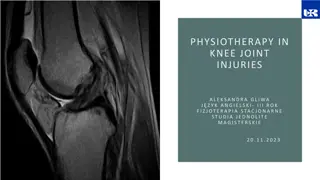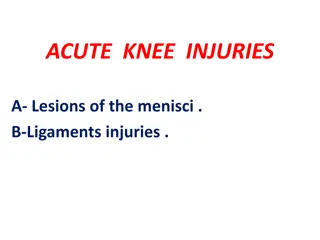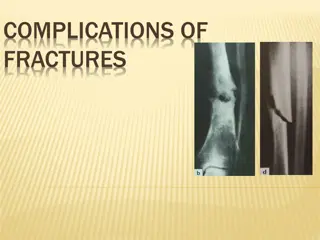
Understanding Ureteral Injuries and Associated Complications
Learn about ureteral injuries, their potential complications, and causes, including trauma from external sources. Recognize the importance of early detection and management to prevent serious consequences like ureteral stricture and fistula.
Download Presentation

Please find below an Image/Link to download the presentation.
The content on the website is provided AS IS for your information and personal use only. It may not be sold, licensed, or shared on other websites without obtaining consent from the author. If you encounter any issues during the download, it is possible that the publisher has removed the file from their server.
You are allowed to download the files provided on this website for personal or commercial use, subject to the condition that they are used lawfully. All files are the property of their respective owners.
The content on the website is provided AS IS for your information and personal use only. It may not be sold, licensed, or shared on other websites without obtaining consent from the author.
E N D
Presentation Transcript
URETERAL INJURIES URETERAL INJURIES
URETERAL INJURIES URETERAL INJURIES An unrecognized or mismanaged ureteral injury can lead to significant complications, including: urinoma Abscess ureteral stricture urinary fistula potential loss of an ipsilateral renal unit
CAUSES CAUSES External trauma Open surgery Laparoscopy Endoscopic procedures
EXTERNAL TRAUMA EXTERNAL TRAUMA Damage to the ureter after external violence is quite rare, occurring in less than 4% of all penetrating and less than 1% of all cases of blunt trauma These patients often have significant concomitant injuries and a devastating degree of mortality that approaches one third
Associated visceral injury is common predominantly small (39% to 65%) and large (28% to 33%) bowel perforation A significant percentage (10% to 28%) of patients with ureteral injuries also has associated renal injuries A smaller percentage (5%) has associated bladder injuries
penetrating trauma imparts a large degree of energy over a small area (as in the course of a bullet) The mechanism by which bullets injure the ureter is: direct transection disruption of the delicate intramural blood supply
patients with blunt trauma with ureteral injuries are subject to extreme force applied over the entire body, like a fall from heights or a high- speed motor vehicle accident The presence of massive force injuries in the patient with blunt trauma should always increase the level of suspicion for ureteral injury
Patients with penetrating trauma with any degree of hematuria or a wound pattern that suggests the possibility of genitourinary injury should be imaged. Patients with blunt trauma with gross hematuria or microhematuria plus hypotension, a history of significant deceleration, or significant associated injuries also should be imaged
SURGICAL INJURY SURGICAL INJURY Analysis of 13 published studies concluded that the following procedures contribute to iatrogenic ureteral injuries: hysterectomy (54%), colorectal surgery (14%) pelvic procedures such as ovarian tumor removal (8%) transabdominal urethropexy (8%) abdominal vascular surgery (6%)
VASCULAR SURGERY. VASCULAR SURGERY. Intraoperative ureteral manipulation resulting in subsequent hydronephrosis is common after aortoiliac and aortofemoral bypass surgery (12% to 20%), but the course is benign in most Surgical devascularization or inflammation can result in symptomatic ureteral stenosis, often delayed in manifestation by months, occurring in only 1% to 2% of these patients
The majority (up to 85%) of surgical injuries to the ureter after vascular procedures are not recognized immediately Postoperative symptoms of missed ureteral injury include flank pain (36% to 90%) fever Ileus abdominal distention urinary fistula
Ureteroarterial fistulas deserve special mention. This rare and potentially catastrophic condition should be diagnosed and treated immediately because it can cause life- threatening hematuria The fistula, mostly between the ureter and ipsilateral iliac artery.
ROBOTIC AND LAPAROSCOPIC SURGERY ROBOTIC AND LAPAROSCOPIC SURGERY the reported rate of ureteral injury varies between 0.5% (experienced surgeons) and 14% (inexperienced surgeons) after laparoscopic hysterectomy Of ureteral injuries during hysterectomy, 50% have no identifiable risk factors. The other 50% are associated with malignancy, endometriosis, prior surgery, and surgery for prolapse
In contradistinction to open operation, in which at least one third of ureteral injuries are recognized immediately, fewer injuries to the ureter are immediately identified after laparoscopy. Therefore, during laparoscopy and robotic surgery, a high index of suspicion for ureteral injury is required.
AVOIDING AND DETECTING URETERAL INJURY. AVOIDING AND DETECTING URETERAL INJURY. Avoidance of ureteral injury is predicated on intimate knowledge of its location, especially its relation to the uterine and ovarian arteries, if those structures are going to be ligated, as in a hysterectomy Visualization of the ureter in the area of the ureterosacral ligaments is thought to be especially difficult, and special care must be taken in this area
Intraoperative hydration or diuretic administration has been suggested to enhance ureteral visualization and potentially decrease the risk for injury Preoperative ureteral stenting can be used to ease identification of the ureter in highrisk cases, although it may increase intraoperative recognition of ureteral injury, it may not actually decrease ureteral injuries
injection of 5 to 10 mL of IV indigo carmine dye followed by cystoscopy to ensure patency of the ureters after laparoscopic hysterectomy. When this technique was used in 118 patients undergoing laparoscopic hysterectomy, 4 of 4 cases of ureteral occlusion were identified immediately (mostly caused by suture ligation) and repaired immediately without complications
THE TENUOUS URETERAL BLOOD SUPPLY. THE TENUOUS URETERAL BLOOD SUPPLY. The distal ureteral blood supply is variable. It is estimated by cadaver studies that 10% of females carry a disproportionate amount of their distal ureteral blood supply via uterine artery branches It has been experimentally proved on cadavers that 40% of females have decreased ureteral perfusion after ligating the uterine artery
Distal ureteral devascularization may be an unavoidable consequence in a small percentage of women after hysterectomy Ureteral devascularization tends to manifest differently from other ureteral injuries Patients tend to present late (more than a week after surgery, but as late as 1 to 2 months), usually with ureteral stenosis, urinoma, or even ureterovaginal fistula
URETEROSCOPIC URETEROSCOPIC INJURY INJURY In fact, ureteroscopic injury was the most common cause of iatrogenic ureteral trauma in some modern series Improvements in equipment and operator experience subsequently decreased the rate of ureteral perforation, to a stable average of 7% in the 1990s
One factor cited as a cause of ureteral injury during ureteroscopy was the persistence of stone basket attempts after recognition of a ureteral tear. Current recommendations are to stop the procedure and place a ureteral stent when ureteral perforations are identified
It is also recommended to perform ureteroscopy alongside or over a wire placed up into the renal pelvis. Factors associated with higher complication rates during ureteroscopy were longer surgery times reatment of renal calculi surgeon inexperience previous irradiation
Factors that are thought to protect against ureteral injury are smaller and flexible ureteroscopes
DIAGNOSIS DIAGNOSIS Gunshot and Stab Gunshot and Stab Wounds Hematuria is a nonspecific indicator of urologic injury Significant ureteral injury can occur in the absence of hematuria a high index of suspicion is required in cases of potential ureteral injury after penetrating trauma. Wounds
INTRAOPERATIVE RECOGNITION INTRAOPERATIVE RECOGNITION Intraoperative detection requires a high degree of suspicion, but there is evidence that specific vigilance for ureteral injuries may decrease the incidence of missed injuries With a 75% sensitivity for traumatic ureteral injury, wound location may be the only indicator for identifying ureteral injury in the acute setting
Intraoperative recognition of ureteral or renal pelvis injury may be aided by using a small needle to inject 1 to 2 mL of methylene blue (10 mg/mL) directly into the renal pelvis. Care must be taken not to inject excessive dye, because it can spill and stain local tissues, making dye determination of the source of leak impossible.
Inadequate exploration or a low index of suspicion in the presence of multiple injuries is often responsible for missed ureteral injury. An unrecognized or undertreated ureteral injury can lead to other significant complications, including urinoma, abscess, ureteral stricture, and urinary fistula
Fever, leukocytosis, and local peritoneal irritation are the most common signs and symptoms of missed ureteral injury and always should prompt CT examination. In contrast to acute injuries, missed injuries that are discovered more than 48 hours after injury may be best diagnosed with retrograde ureterography if possible
IMAGING STUDIES IMAGING STUDIES Excretory Urography Excretory Urography Ureteral injuries after external violence, unlike renal injuries, are difficult to detect with the usual array of diagnostic tools: preoperative urinalysis, CT scan, and intraoperative one-shot IVP.
However, in the absence of a better test, we still recommend intraoperative one-shot pyelography together with intraoperative inspection to detect ureteral injuries and assess the functional status of the contralateral system
COMPUTED TOMOGRAPHY. COMPUTED TOMOGRAPHY. Ureteral injuries can be difficult to diagnose on CT Because modern helical CT scanners can obtain images rapidly, before IV contrast dye is excreted in the urine, delayed images must be obtained (5 to 2 minutes after contrast injection) to allow contrast material to extravasate from the injured collecting system, renal pelvis, or ureter
Because ureteral injuries are often detected late, periureteral urinoma seen on delayed CT scans
RETROGRADE RETROGRADE URETEROGRAPHY URETEROGRAPHY. . The most sensitive radiographic test for ureteral injury Delineate the extent of ureteral injury seen on CT scan or IVP if further clinical information is needed. Most commonly used to diagnose initially missed ureteral injuries, because it allows the simultaneous placement of a ureteral stent if possible
ANTEGRADE ANTEGRADE URETEROGRAPHY URETEROGRAPHY Anterograde ureterography is seldom used in our practice
MANAGEMENT MANAGEMENT
GENERAL PRINCIPLES GENERAL PRINCIPLES 1. Mobilize the injured ureter carefully, sparing the adventitia widely, so as not to devascularize the ureter further. 2. Debride the ureter minimally but judiciously until edges bleed, especially in high-velocity gunshot wounds. 3. Repair ureters with spatulated, tension-free, stented, watertight anastomosis, using fine absorbable monofilament such as 5-0 polydioxanone and retroperitoneal drainage afterward. Use optical magnification if necessary.
4. Retroperitonealize the ureteral repair by closing peritoneum over it if possible 5. Do not tunnel ureteroneocystostomies but rather create a widely spatulated nontunneled anastomosis. 6. With severely injured ureters, blast effect, concomitant vascular surgery, and other complex cases, consider omental interposition to isolate the repair when possible. 7. If immediate repair is not possible, tie off the ureter with long silk sutures and plan to repair it later (damage control). Ipsilateral drainage can be achieved by placing a single J stent brought out cutaneously or a percutaneous nephrostomy tube placed later
EXTERNAL TRAUMA EXTERNAL TRAUMA Contusion Contusion. . Ureteral contusions, although the most minor of ureteral injuries, can heal with stricture Severe or large areas of contusion should be treated with excision of the damaged area an ureteroureterostomy/ureteroneocystostomy The safest approach in ureteral contusions that do not appear to require excision/anastomosis is to place a ureteral stent
Management of ureteral leak is by percutaneous nephrostomy placement and ureteral catheter placement for at least 6 weeks,
UPPER URETERAL INJURIES UPPER URETERAL INJURIES Ureteroureterostomy Ureteroureterostomy. . Ureteral avulsion from the renal pelvis, or even very proximal ureteral injury, can be managed by reimplantation of the ureter directly into the renal pelvis Ureteroureterostomy, or so-called end-to-end repair, is used in injuries to the upper two thirds of the ureter
Complications after ureteroureterostomy, usually urine leakage, occur 10% to 24% of the time. Other acute complications include abscess and fistula Chronic complications, usually ureteral stenosis, are less common, involving approximately 5% to 12% of patients
Autotransplantation Autotransplantation. . Autotransplantation of the kidney has been used after profound ureteral loss or after multiple attempts at ureteral repair have failed This maneuver remains the final option before nephrectomy
Bowel Interposition Bowel Interposition. . Delayed ureteral repairs, especially when a very long segment of ureter is destroyed, also can be performed by creation of a ureteral conduit out of ileum in much the same way that an ileal conduit is constructed to drain the urine after cystectomy Success rates for ileal replacement of the ureter have been reported to be 81% to 100%
Ileal interposition is not suggested for acute repair of ureteral injury but rather would be used in delayed or staged repairs
Monitoring after Ureteral Repair Monitoring after Ureteral Repair. . leave the stent in for 6 weeks At the time of stent removal, usually perform a retrograde ureterogram to document healing without leakage or stenosis One month postoperatively, perform a furosemide (Lasix) renogram to document that the system continues to be unobstructed Four months postoperatively, perform a renal ultrasound to document lack of hydronephrosis
Nephrectomy Nephrectomy. . Rarely, acute nephrectomy is required to treat ureteral injury after external violence Reasons for nephrectomy include associated severe visceral injuries (although damage control without nephrectomy is nearly always preferable) or severe associated injury to the ipsilateral kidney when renal repair is not possible
Delayed nephrectomy may be required because of: poor renal function (which can sometimes be seen after delayed recognition of an obstructing ureteral injury) severe panureteral injury when ileal ureter or other reconstruction is impossible persistent ureteral fistula (especially vascular fistula) despite previous intervention
MIDURETERAL MIDURETERAL INJURIES INJURIES Transureteroureterostomy. Transureteroureterostomy. This form of repair involves bringing the injured ureter across the midline and anastomosing it end-to-side into the uninjured ureter most often performed as a secondary or delayed procedure. Caution is required while performing this procedure because it involves surgery on the uninjured, contralateral ureter with the theoretical risk for converting unilateral ureteral injury into (iatrogenic) bilateral ureteral injury






















